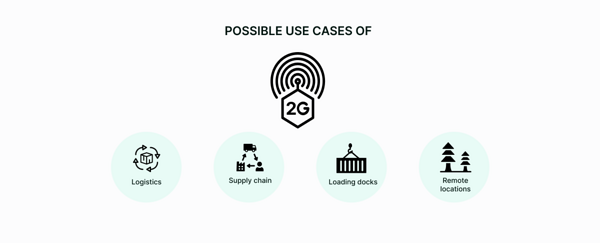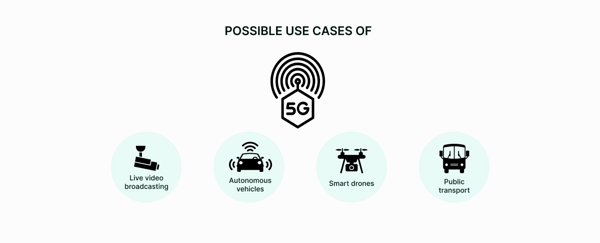This article was updated on April 15th, 2024.
The evolution of mobile network infrastructure and protocols go a long way back. Every new generation of mobile networks has offered new opportunities for end-users.
Today, we still have the traditional cellular networks in use - 2G, 3G, 4G and the addition of 5G. Still, new technologies like NB-IoT and LTE-M are being deployed.
When it comes to picking the right network type for your cellular-based IoT project, decision-making might get tricky.
IoT and cellular networks
When it comes to M2M and IoT devices, all the networks mentioned above are technically accessible, and cellular modems are available. However, there are many things to consider when choosing the proper cellular network modem for your next project.
First you need to think of the bigger picture and decide, in which regions your devices will be used. Will there be any roaming restrictions in the area to consider? Or if there even is a full coverage of 2G / 3G / 4G / 5G or NB-IoT / LTE-M in that region.
There are several open-source options (along with telecom coverage maps) for finding out the coverage of mentioned network types in different regions. One example would be the OpenSignal application, which has crowdsourced coverage maps.2G and 3G – what are they, and are they still in use?
2G (short for second-generation cellular network) was first launched on the GSM standard in 1991. The technology enabled networks to provide novel services such as text and picture messages and MMS (multimedia messages).
With General Packet Radio Service (GPRS), 2G offers a theoretical maximum transfer speed of 40 kbps. With Enhanced Data Rates for GSM Evolution (EDGE), the theoretical maximum transfer speed is up to 384 kbps.
Despite being a legacy network, quite a few industries make good use of 2G. Especially industries like logistics and supply chain, which usually involve devices that work in less populated areas. These could include remote loading docks where shipments are handled or remote locations in asset tracking.
2G is still a great option in those cases because the new cellular networks have some shortcomings. The new technologies have a smaller coverage and the networks rely on more widespread physical installation sites, such as masts. Therefore, they are mostly concentrated around larger cities. Also, 2G cellular modules are cheap, which is often the main reason why IoT device manufacturers choose to use 2G technology over the others.
3G is the third generation of wireless cellular network technology, created as an upgrade for 2.5G GPRS and 2.75G EDGE networks for faster data transfer. That said, 3G networks support services that provide an information transfer rate of up to 700 kbps.Later 3G releases, 3.5G and 3.75G, provide mobile broadband access of Mbps. This ensures that the network can be used for wireless voice telephony, Internet access through mobile and fixed wireless networks, video calls, and even mobile TV technologies.
3G might be helpful in the healthcare industry, where patient tracking and monitoring don't need the bells and whistles of 4G and 5G. While upgrading to these newer cellular network technologies won't be difficult, it will create additional costs for both healthcare providers and patients.
That being said, 2G and 3G networks are subject to being shut down in the coming years. This means that IoT devices using such network modems might end up disconnected.
In most cases, countries have chosen to shut down either 2G or 3G, not both. The procedure usually takes about 1-2 years and requires careful examination and support by the local mobile operators.
Region-wise, Europe is considering shutting down 3G before 2G (e.g., Telenor in Norway). In contrast, telecoms in the USA are doing the opposite - shutting down 2G networks.
A complete overview of 2G and 3G sunsets with dates can be found in our blog.
4G - currently the most popular wireless cellular network
4G is a loose term for the fourth generation of cellular communications. It offers data transmission speeds about 10 times faster than 3G. Each generation of wireless cellular technology has increased bandwidth speeds and network capacity. 4G users get speeds of up to 100 Mbit/s.
4G coverage is currently considered the best cellular network around the world. Operators have been launching 4G for many years, and it's not being shut down anytime soon.
While the coverage is good, 4G is not the best option for many IoT devices because of higher module costs and high power consumption. Oftentimes, IoT devices don’t need the high-speed data connections that 4G offers.
5G - the new dream network
5G networks are cellular networks where the service area is divided into small geographical areas called cells. 5G is a huge step forward from 4G and its new developments (4.5G, 4.75G). The main advantage of the new networks is that they have greater bandwidth and, therefore, higher download speeds of over 2 Gbps.
The 5G network will be a good option for IoT devices and vehicles which use tens of gigabytes of data per month or need to be connected to mobile networks in real-time and 24/7.
To learn more about 5G and how it works with IoT devices, we have covered the technology behind 5G and end-users perspectives towards it in our blog.
NB-IoT and LTE-M - the rising stars for M2M cellular networks
The problem we face today in the IoT field is that mobile networks are not optimized for many devices in a small area (all but 5G).
A considerable number of IoT deployments use a minimal amount of data per month, for example, between 10KB and 1MB. The telecom world is moving towards alternative network solutions—NB-IoT and LTE-M.
To learn more about these technologies and which one suits your IoT project, read our Definitive Guide to LPWAN - NB-IoT vs LTE-M Comparison blog post.
Conclusion
Today, many cellular modules already support multiple bands. Still, to make sure which cellular networks your hardware supports, you need to check the cellular module’s specifications.
In summary, when planning to launch your next cellular-based IoT device or application, you should consider:
- the coverage of different network types
- supported frequency bands
- fallback options from soon-to-be-closed networks
- data consumption requirements.
Contact sales







